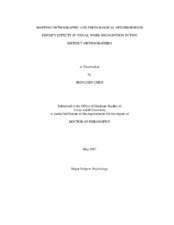| dc.contributor.advisor | Vaid, Jyotsna | |
| dc.creator | Chen, Hsin-Chin | |
| dc.date.accessioned | 2010-01-14T23:56:32Z | |
| dc.date.accessioned | 2010-01-16T01:40:59Z | |
| dc.date.available | 2010-01-14T23:56:32Z | |
| dc.date.available | 2010-01-16T01:40:59Z | |
| dc.date.created | 2007-05 | |
| dc.date.issued | 2009-05-15 | |
| dc.identifier.uri | https://hdl.handle.net/1969.1/ETD-TAMU-1365 | |
| dc.description.abstract | A central issue in word recognition is how readers retrieve and select the right
representation among others in the mental lexicon. Recently, it has been claimed that
recognition of individual words is influenced by the degree to which the words possess
unique vs. shared letters or sounds relative to other words, that is, whether the words
have few or several neighbors. Research on so-called neighborhood density effects
advances understanding of the organization and operation of the mental lexicon.
Orthographic neighborhood effects have been claimed to be facilitative, but recent
studies of visual word recognition have led to a revised understanding of the nature of
the orthographic neighborhood density effect.
Through a reexamination of orthographic and phonological neighborhood density
effects, the specific objective of the present research is to understand how orthographic
and phonological representations interact across two different writing systems, i.e.,
English (an alphabetic orthography) and Chinese (a morphosyllabic orthography). The
phenomena were studied using a joint behavioral (lexical decision) and neural imaging
approach (near infrared spectroscopy, or NIRS). Orthographic and phonological (more, specifically, homophone) neighborhood
density were manipulated in three lexical decision experiments with English and three
with Chinese readers. After different sources of facilitative inter-lexicon connections
were controlled, orthographic and phonological neighborhood density effects were found
to be inhibitory in both writing systems. Inhibitory neighborhood density effects were
also confirmed in two NIRS experiments of English and Chinese.
The present research provided a better control of lexical characteristics than was
the case in previous research on neighborhood effects and found a clear and consistent
pattern of neighborhood density effects. This research supports interactive-activation
models of word recognition rather than parallel-distributed models, given the evidence
for lateral inhibition indexed by inhibitory neighborhood density effects. As such, the
present study furthers the understanding of the organization and operation of the mental
lexicon. | en |
| dc.format.medium | electronic | en |
| dc.format.mimetype | application/pdf | |
| dc.language.iso | en_US | |
| dc.subject | Orthographic Neighborhood Density | en |
| dc.subject | Phonological Neighborhood Density | en |
| dc.subject | Visual Word Recognition | en |
| dc.subject | Near Intrared Spectroscopy | en |
| dc.title | Mapping orthographic and phonological neighborhood density effects in visual word recognition in two distinct orthographies | en |
| dc.type | Book | en |
| dc.type | Thesis | en |
| thesis.degree.department | Psychology | en |
| thesis.degree.discipline | Psychology | en |
| thesis.degree.grantor | Texas A&M University | en |
| thesis.degree.name | Doctor of Philosophy | en |
| thesis.degree.level | Doctoral | en |
| dc.contributor.committeeMember | Bortfeld, Heather | |
| dc.contributor.committeeMember | Joshi, R. Malatesha | |
| dc.contributor.committeeMember | Smith, Steven M. | |
| dc.type.genre | Electronic Dissertation | en |
| dc.type.material | text | en |
| dc.format.digitalOrigin | born digital | en |


